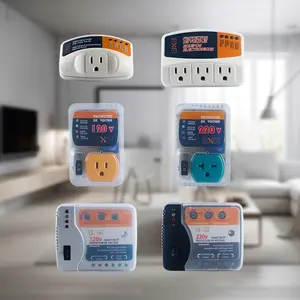Introduction to Voltage Monitor Devices
A voltage monitor device is an essential tool used in various electrical applications to ensure the safety and efficiency of electrical systems. These devices are designed to detect fluctuations in voltage levels, providing crucial data that protects equipment from potential damage due to overvoltage or undervoltage scenarios. As technology evolves, the need for reliable voltage monitoring has become increasingly important across numerous industries, including manufacturing, construction, and renewable energy. This guide will delve into the different types, functions, and applications of voltage monitor devices.
Types of Voltage Monitor Devices
Voltage monitor devices come in various forms, each tailored to meet specific operational requirements. Understanding the types available can help in selecting the most suitable one for your application:
- Analog Voltage Monitors: These devices provide visual indications of voltage levels using analog gauges, ideal for straightforward applications.
- Digital Voltage Monitors: Offering precise digital readings, these monitors often include data logging features for advanced analysis.
- Remote Voltage Monitors: These devices enable off-site monitoring via internet connectivity, allowing operators to stay informed regardless of location.
- Smart Voltage Monitors: Equipped with IoT technology, these monitors can integrate with other smart devices for enhanced automation and data analysis.
Function and Features of Voltage Monitor Devices
Voltage monitor devices serve a critical function in the stability and safety of electrical systems. Here are some key features:
- Real-Time Monitoring: Continuously assesses voltage levels and alerts users to any anomalies.
- Alarm System: Many devices feature audible and visual alarms to indicate out-of-range voltage levels.
- Programmable Settings: Users can set threshold values for alarms and alerts according to specific operational needs.
- Logging and Reporting Features: Advanced models provide historical data and generate reports to track performance over time.
- Compatibility: Voltage monitors can integrate with existing electrical systems and solutions, enhancing functionality.
Applications of Voltage Monitor Devices
The versatility of voltage monitor devices makes them suitable for a multitude of applications across various sectors:
- Industrial Automation: Used in factories to oversee machinery performance and prevent downtime.
- Renewable Energy Systems: Essential in solar and wind applications to manage voltage levels effectively.
- Commercial Buildings: Helps in managing energy consumption and improving efficiency in electrical systems.
- Residential Settings: Increasingly used in homes to protect appliances from voltage fluctuations.
- Telecommunications: Ensures reliable power supply to communication equipment.
Advantages of Voltage Monitor Devices
The incorporation of voltage monitor devices provides several advantages, contributing to enhanced operational efficiency and safety:
- Prevention of Equipment Damage: By monitoring voltage levels, these devices help prevent damage to sensitive equipment.
- Cost Efficiency: Early detection of electrical issues can save on repair and replacement costs.
- Operational Stability: Maintains consistent voltage levels, facilitating uninterrupted operations.
- Data-Driven Decisions: Provides valuable information that can aid in energy management and system optimization.
- Enhanced Safety: Reduces the risk of electrical hazards through timely alerts and monitoring.



































































































































































































